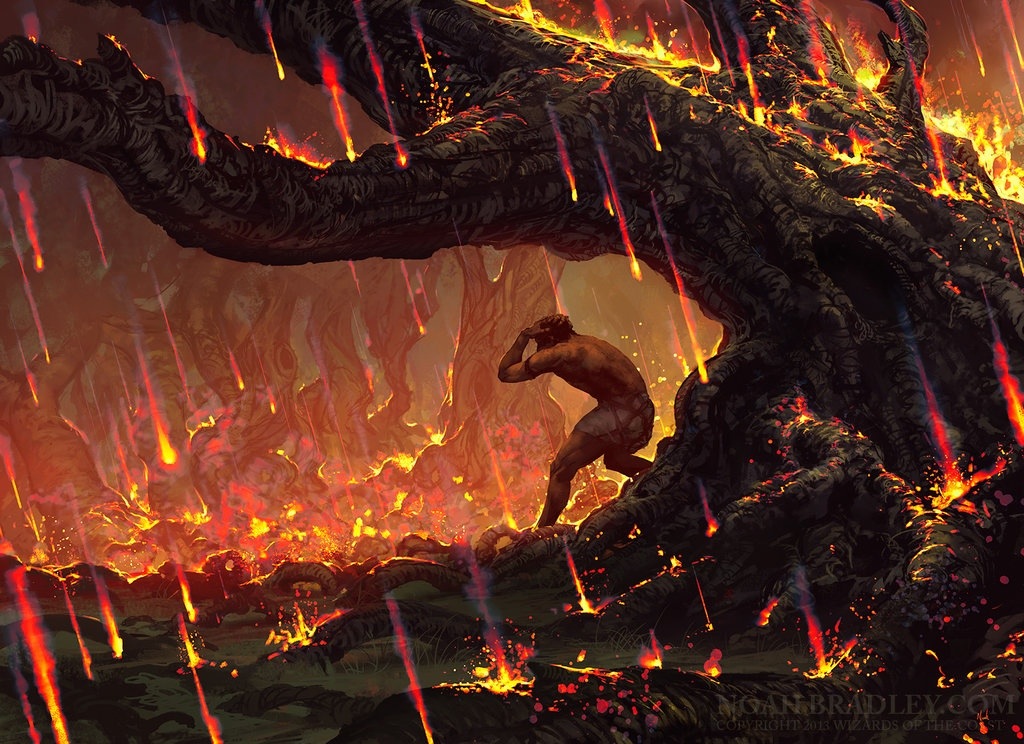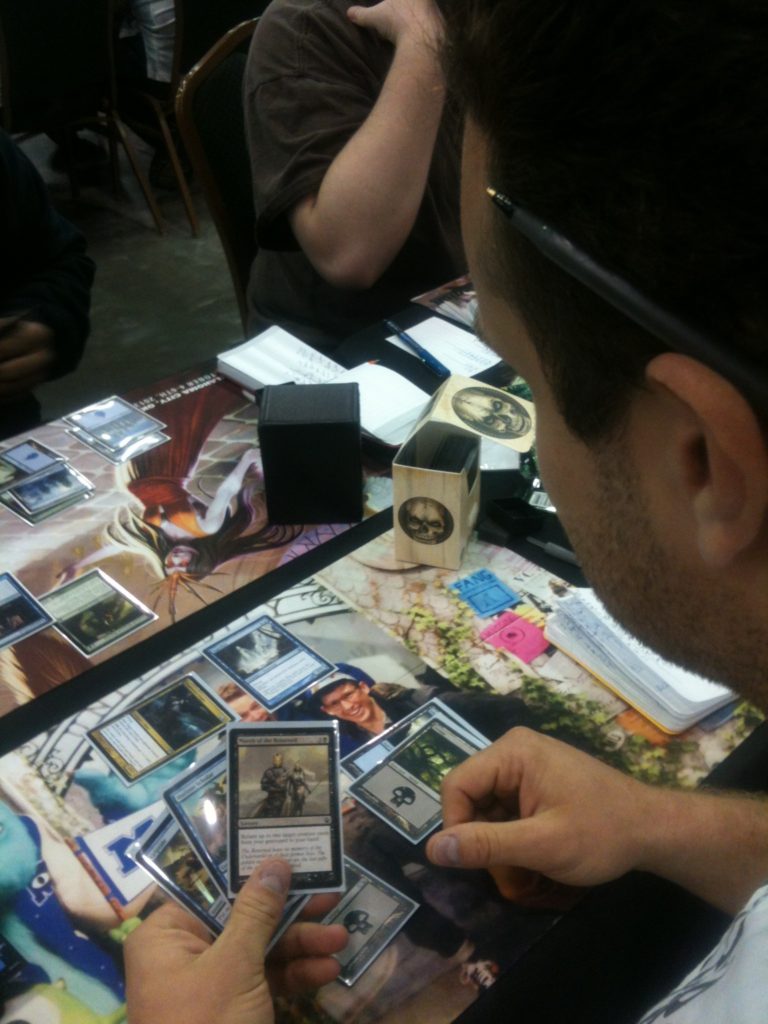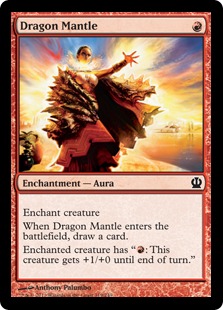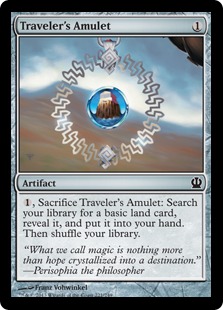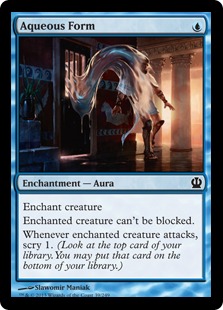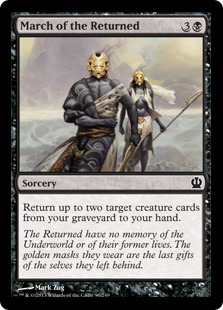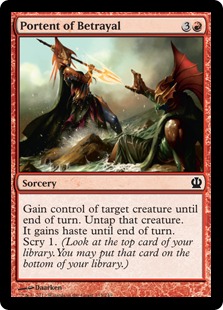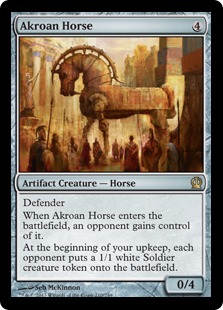Howdy drafters! How’s everyone loving Theros limited? Isn’t it great how many diverse and fun decks are viable? What’s that? You lost the die roll and your opponent kept a seven card hand of Island, Island, Plains, Favored Hoplite, Battlewise Hoplite, Ordeal of Thassa, Aqueous Form? On your third turn you untapped with 13 life facing down a 4/5 and a 3/3 unblockable, and your opponent had four cards still in hand?
Yeah. That’s a loss. Your cards don’t really matter. Maybe you have Voyage’s End, or you live on some bizarro plane where you maindeck Glare of Heresy. Griptide or Divine Verdict might be fast enough. Oh, you’re playing black or red, the traditional removal colors? Hope you opened a Hero’s Downfall. And drew it. And three lands. And you can dodge Gods Willing, gods willing.
You could (and should) play a Baleful Eidolon on turn two, but even if you do, they’ll just put Aqueous Form on the Favored Hoplite instead and swing for five.
That’s the god draw from the best aggro deck, though. Triple Return to Ravnica had some oppressive Rakdos starts involving Rakdos Cackler into Rix Maadi Guildmage. These things are a part of limited, like mana screw. Even the great draft format Innistrad had crap like Invisible Stalker plus Butcher’s Cleaver or Silver-Inlaid Dagger. There’s a reason even the best Magic players have lifetime Sanctioned-event win rates under 70%. Sometimes the cards line up poorly and you just lose.
But the frustration with triple-Theros draft runs deeper than this. The format often leads to situations where one player has a dominating board position and the other player has absolutely no way to get back in the game. It’s like when your opponent has Jace, the Mind Sculptor active for more than one turn. You’re dead, but the cat wants to play with its food for a bit. For example, it’s turn eight and your opponent has three creatures on board: Nessian Asp, Vulpine Goliath, and Nemesis of Mortals. You are playing blue-red. What exactly are you going to do about this, besides die? At best you can cast Sea God’s Revenge to buy some time, but unless you have creatures on board that can attack for the win over two or three turns, you’re just delaying the inevitable. Anger of the Gods doesn’t do much unless you can attack with some Crackling Tritons and bait some blocks to make the three damage sweeper into a full wrath. Your best bet is to avoid drafting blue red, which is probably the worst color combination. Black offers some some hope, between Baleful Eidolon, Keepsake Gorgon, Sip of Hemlock, and Hythonia the Cruel (if you are so lucky), but you’re still on the back foot and vulnerable to one more spell from your opponent.
Enough lamenting. Let’s look at why we end up in this situation and figure out how to avoid it. Perhaps you’ve heard people say that Theros limited is a “synergy” format. Maybe you’ve even heard it from me. Or if you listen to the Limited Resources podcast run by Marshall Sutcliffe and Brian Wong, you may have heard the episode where Brian David-Marshall classified limited formats as either “prince” or “pauper” formats. (If you don’t listen to that podcast, you should. It’s a gold mine.) Basically, a synergy (or pauper) format is one where the individual cards are weak but they combine to do powerful things. A bomb-driven (or prince) format relies on individually powerful cards (both threats and removal) to decide the outcome of the games.
My theory is this: synergy formats lead to more frustration and feelings of helplessness than bomb-driven formats. Why? Because in synergy formats, you need multiple cards to achieve powerful effects, whereas in bomb-driven formats you only need to top deck a single card to swing the game. Since you only draw one card per turn (without doing something else to get extra card draw), it is harder to come back from a losing position when you need multiple turns to draw enough cards to form an answer. Add in the exponential nature of probability (drawing two specific cards in succession is a lot less likely than getting two shots to draw one card) and things can spiral out of control quickly in a synergy format. In addition, drafting a deck is more difficult because you need to put pieces together that enhance each others’ power, rather than jamming together all the strongest cards you can cast.
So what do you do about this? Draft underrated cards that work well together, and build a deck with a plan that your opponent has to spend resources to answer. Put the onus on the other side of the table to assemble answers to your threats. That’s doesn’t mean you have to play aggro. You just have to harness the power of synergy. Gods know you won’t be able to rely on single powerful cards to answer your opponent’s threats.
Here are a few cards that you can put to good use that have been going late in Theros drafts. These underrated gems can bring your deck’s power level up where it needs to be to compete in the draft metagame.
Each color has a cantrip enchantment: Dragon Mantle, Nylea’s Presence, Chosen by Heliod, Fate Foretold, and Scourgemark. All of them are good. All but Nylea’s Presence can trigger heroic and all of them build devotion. The red one has the strongest ability, but what’s most important about these cards is they dig deeper into your deck. Theros does not have a lot of ways to draw cards. How many times do you scry on your turn, see a great card, and then sadly pass the turn to wait for the chance to draw that card after you untap? Wouldn’t you rather cast Dragon Mantle to pick up that Gods Willing after you cast Spark Jolt before combat? Sometimes you might keep a card on top off a scry when you can draw it the same turn, while you would have to send it to the bottom if you have to wait until next turn to draw it.
In addition, cantrips help you dig to lands. Everyone has been saying this is an 18 land format because there are so many expensive mana sinks, like Monstrosity. The cost to running an 18th land in your deck, however, is one less business spell. In a bomb-driven format, your individual cards are so powerful that you just need to be able to cast them, and you can afford to play more lands. But in a synergy format, you have to combine weaker cards to achieve powerful effects. Having to cut one card to make room for land 18 weakens your ability to harness your deck’s synergies. Cantrips make your deck play like it has more lands than it does, because you dig deeper for a low cost. It’s like cycling where you get a somewhat useful effect tacked on. None of these are quite Gempalm Incinerator, but the cantrip effect is so valuable in this format that these cards are much stronger than they look.
They lose value if you have to spend all your early mana putting creatures on board to block. Even then, it might be right to play something like Triton Shorethief turn one into Fate Foretold, just to put up a speed bump and dig to enough lands and midgame plays. I hope the Heroic decks aren’t so good we have to resort to that, but it’s something to consider. Nylea’s Presence also gains value by not requiring a creature to cast. If you have the mana, you have a target.
This format doesn’t have too many super-powerful cards, but there are a few. Splashing a mountain for Chained to the Rocks or an island for Thassa’s Emissary and Sea God’s Revenge is a good idea, and Traveler’s Amulet makes it easier. This card fits in any deck, and it’s not too hard to pick up one or two in the latter picks of the draft packs. Additionally, you can use Amulets to replace extra lands, so they don’t take up space your deck needs for the critical mass of synergy cards. Along with the cantrip enchantments, the Amulet helps you play 18 lands without actually playing 18 lands.
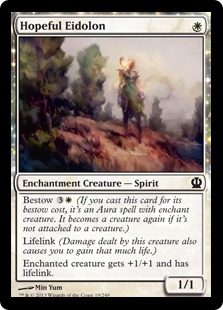 Lifegain is really useful in this format. When the best aggro decks can hit your for eight or more damage by turn three, and can surprise you with a final hit with cards like Portent of Betrayal or Sea God’s Revenge, you want to cushion your life total so that you don’t die the turn you think you stabilized. Also, there’s this traveling salesman who shows up in black decks and domes you for six. Hopeful Eidolon is basically Gift of Orzhova except you get a bonus Trained Caracal instead of flying. The Eidolon is fantastic in Heroic decks, but it’s strong in any deck that can produce white mana. The cheap bestow cost lets you slap this on whatever big creature you have in play while holding up mana to protect yourself, play another creature, or simply bluff. And sometimes you actually do need to drop a 1/1 lifelink to get in the way of an army of Akroan Crusaders or wear an aura. It’s nice you can maindeck that effect without losing a card slot. Seriously, this card is strong and will probably be harder to get in drafts the deeper we go into the format. Another “inefficient” spell with some lifegain attached is Time to Feed.
Lifegain is really useful in this format. When the best aggro decks can hit your for eight or more damage by turn three, and can surprise you with a final hit with cards like Portent of Betrayal or Sea God’s Revenge, you want to cushion your life total so that you don’t die the turn you think you stabilized. Also, there’s this traveling salesman who shows up in black decks and domes you for six. Hopeful Eidolon is basically Gift of Orzhova except you get a bonus Trained Caracal instead of flying. The Eidolon is fantastic in Heroic decks, but it’s strong in any deck that can produce white mana. The cheap bestow cost lets you slap this on whatever big creature you have in play while holding up mana to protect yourself, play another creature, or simply bluff. And sometimes you actually do need to drop a 1/1 lifelink to get in the way of an army of Akroan Crusaders or wear an aura. It’s nice you can maindeck that effect without losing a card slot. Seriously, this card is strong and will probably be harder to get in drafts the deeper we go into the format. Another “inefficient” spell with some lifegain attached is Time to Feed.
Evasion. Evasion evasion evasion evasion evasion. You need ways to get damage through and you need to put your opponent on a clock. Cards like Aqueous Form are important for the format. The Form also triggers Heroic and the scry each turn helps you dig for protection, answers, more threats, more lands, whatever. Applying a clock is even more powerful in a synergy format than normal because your opponent probably needs multiple draw steps to set up an answer if they don’t already have one. Some other cards in this category include Cavalry Pegasus, Cavern Lampad, Agent of Horizons, and even the much-maligned Prowler’s Helm. You only need one or two cards like this, but adding the effect to your deck gives you ways to close out a game.
Draw two cards! What cards do you want to draw with this? How about the Baleful Eidolon and Sedge Scorpion you traded off for your opponent’s early threats? Most players will run a Nessian Courser into a 1/1 deathtouch to clear the way for their big monsters. Watch your opponent’s shoulders slump when they do this on turn five and then play Nemesis of Mortals, only to pass and see you cast March of the Returned plus Sedge Scorpion, with another creature back in your hand to follow up. People say this is a bad format for blocking. Not when you can draw creatures from your graveyard!
You can also go really deep in the recursion with Mnemonic Wall, and get extra value from self-mill out of Returned Centaur or Commune with the Gods. I think the black/green/blue self-mill deck might be a real thing in this format. There’s no Gnaw to the Bone or Spider Spawning, but you can grind a lot of card advantage with graveyard recursion. The big prize is Rescue from the Underworld bringing back Gray Merchant of Asphodel, but if you can out-attrition your opponent, a Benthic Giant can finish the game just fine. Check back in a few weeks on this one.
So your opponent has a Vulpine Goliath beating you down, and you can’t quite win the race with your little creatures? Or maybe you’ve been beating down and your opponent think’s they’ve stabilized with a Sealock Monster to hold off your team? This card is importent to solving such problems. And hey, if your opponent survives, at least you get to scry!
It’s no Assemble the Legion, but if you need a stream of future chump blockers to deal with a Nemesis of Mortals you have no way to kill, this woodshop project can buy you some time. Combine the Horse with an evasive clock and you can pull out a win over a few turns, especially if you get the Horse out early enough to build up some tokens before you have to start chumping. It’s enough to crown Akroan Horse the best steed in the format. Ride it to victory!
I hope these card tips give you some ideas on how to build synergy into your deck with later picks in the draft. You don’t have to be in a niche archetype to plan around picking up roleplayer cards on the wheel. You need to build your deck with these roleplayers. Theros has a lot of playable but unimpressive cards, and maximizing your resources is the key to victory. Let me know in the comments if you have any other underrated cards that have performed well in Theros draft. Also, don’t play blue red.
Carrie O’Hara is Editor-in-Chief of Hipsters of the Coast.

